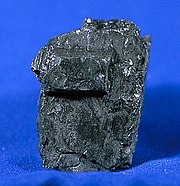Fossil fuel
From Wikipedia, the free encyclopedia
Fossil fuels or mineral fuels are fossil source fuels, that is, hydrocarbons found within the top layer of the Earth’s crust.
Fossil fuels range from volatile materials with low carbon:hydrogen ratios like methane, to liquid petroleum to nonvolatile materials composed of almost pure carbon, like anthracite coal. Methane can be found in hydrocarbon fields, alone, associated with oil, or in the form of methane clathrates. It is generally accepted that they formed from the fossilized remains of dead plants and animals[1] by exposure to heat and pressure in the Earth's crust over hundreds of millions of years.[2] This biogenic theory was first introduced by Georg Agricola in 1556 and later by Mikhail Lomonosov in 1757.
It was estimated by the Energy Information Administration that in 2005, 86% of primary energy production in the world came from burning fossil fuels, with the remaining non-fossil sources being hydroelectric 6.3%, nuclear 6.0%, and other (geothermal, solar, wind, and wood and waste) 0.9 percent.[3]
Fossil fuels are non-renewable resources because they take millions of years to form, and reserves are being depleted much faster than new ones are being formed. Concern about fossil fuel supplies is one of the causes of regional and global conflicts. The production and use of fossil fuels raise environmental concerns. A global movement toward the generation of renewable energy is therefore under way to help meet increased energy needs.
The burning of fossil fuels produces around 21.3 billion tones (21.3 gigatons) of carbon dioxide per year, but it is estimated that natural processes can only absorb about half of that amount, so there is a net increase of 10.65 billion tones of atmospheric carbon dioxide per year (one tonne of atmospheric carbon is equivalent to 44/12 or 3.7 tones of carbon dioxide).[4] Carbon dioxide is one of the greenhouse gases that enhances radiative forcing and contributes to global warming, causing the average surface temperature of the Earth to rise in response, which climate scientists agree will cause major adverse effects, including reduced biodiversity.


No comments:
Post a Comment